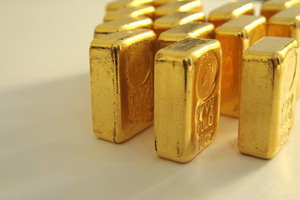
For more than 18 months, gold bullion has been trading between US$1,150 and US$1,350 an ounce. Indeed, investors who bought into bullion funds at the peak in the summer of 2011 would have seen losses of about 8% a year, turning $10,000 into $7,700. Yet for those who are about to throw in the towel, there could be some respite, or even a glimmer of hope that bullion will once again see those headier days when it peaked at US$1,900 an ounce.
That’s if you buy into the conditions that will cause gold to rise phoenix-like from the ashes again, as outlined by Onno Rutten, vice-president at Toronto-based Mackenzie Investments.
“The current pattern could still extend for a bit longer — potentially another year. Right now the world is figuring out the central-bank activity, in the U.S., Europe and Japan, and what it will mean for real interest rates,” says Rutten, lead manager of Mackenzie Precious Metals Class. “While the market is trying to figure that out, gold is somewhat aimless.”
Rutten joined Mackenzie Investments in 2011 after a career working as a process engineer in South Africa and Australia and later as a metals and mining analyst for Scotia Capital and UBS. He holds a master of science in mining and engineering from Delft University, in The Netherlands and an MBA from INSEAD in Paris.
Contrary to investors who link the gold price to inflationary pressures, Rutten argues that what matters are interest rates after inflation is taken into account. Today, the real rate is close to zero, but consensus market expectations are for real rates to rise as the U.S. recovery accelerates.
“If this current ‘just right’ or ideal economic environment plays out, then gold will remain under pressure. Because if real rates are rising, then the opportunity cost of holding gold is going up. In a positive interest-rate world, you can invest in other asset classes and get a return,” says Rutten.
There is a risk that gold could even go to US$1,100 an ounce and possibly lower on a short-term basis, says Rutten. “This is the base case that the market is focused on — and why gold is in this no man’s land.”
Rutten argues that investors should consider two alternative scenarios which would be positive for gold. Both revolve around the possibility of an error by policy-makers. In scenario No. 1, the U.S. Federal Reserve hikes interest rates too slowly. In this case, inflation, which is already building up pressure, could pick up rapidly. “Unemployment is already quite low, so wage pressure is building,” says Rutten. “The big surprise for the market would be to see headline inflation really pick up in 2015.”
After years of printing billions of dollars, the Fed has been hesitant about raising rates prematurely. “There is a real risk that the Fed is too late and we’ll see 2.5% to 3% inflation,” Rutten says. “The normal inflationary cycle is that wages go up, and people start spending and prices go up. We’re already at the start of that.”
Moreover, if the Fed hikes modestly, but inflation is increasing, then real rates are declining or negative. “This would be very bullish for gold.”
Rutten offers historical data, based on an analysis of real interest rates in the period 1971 to 2013, that gold prices achieved a monthly annualized return of 28% during periods of low, and declining real rates — “not dissimilar from where we are today.”
Scenario No. 2 revolves around the Fed panicking about rising inflation and hiking rates too quickly. “There is plenty of history that shows when the Fed hikes rates too fast, it will kill the economic momentum and the economy stalls,” says Rutten.
“The issue with hiking rates is that we’re coming from a 0% environment. There is an open question about how consumers will respond to a rapid rate-hike scenario,” says Rutten. Should the U.S. economy suddenly stall, in the worst-case scenario, Rutten suggests that the Fed may have to unveil a fourth round of quantitative easing, or QE4, to prime the economic pump by printing more money.
Last year, Rutten’s forecasting model suggested that gold should have been as high as US$1,600 an ounce. But it didn’t come to pass, Rutten admits, as the market started to anticipate the “tapering” of QE3. Moreover, gold underperformed even as central banks continued to expand the global monetary base. So Rutten is cautious about forecasts for 2015, although laying out two scenarios where gold can break out on the upside.
“But I want to be balanced in my view,” says Rutten. “If the Fed manages to go down a path of modest inflation, good economic growth and a gradual rate hike path, then gold bullion prices might not go anywhere. But I don’t want to be fully exposed to a ‘perfect’ scenario. I want to protect myself against policy errors.”